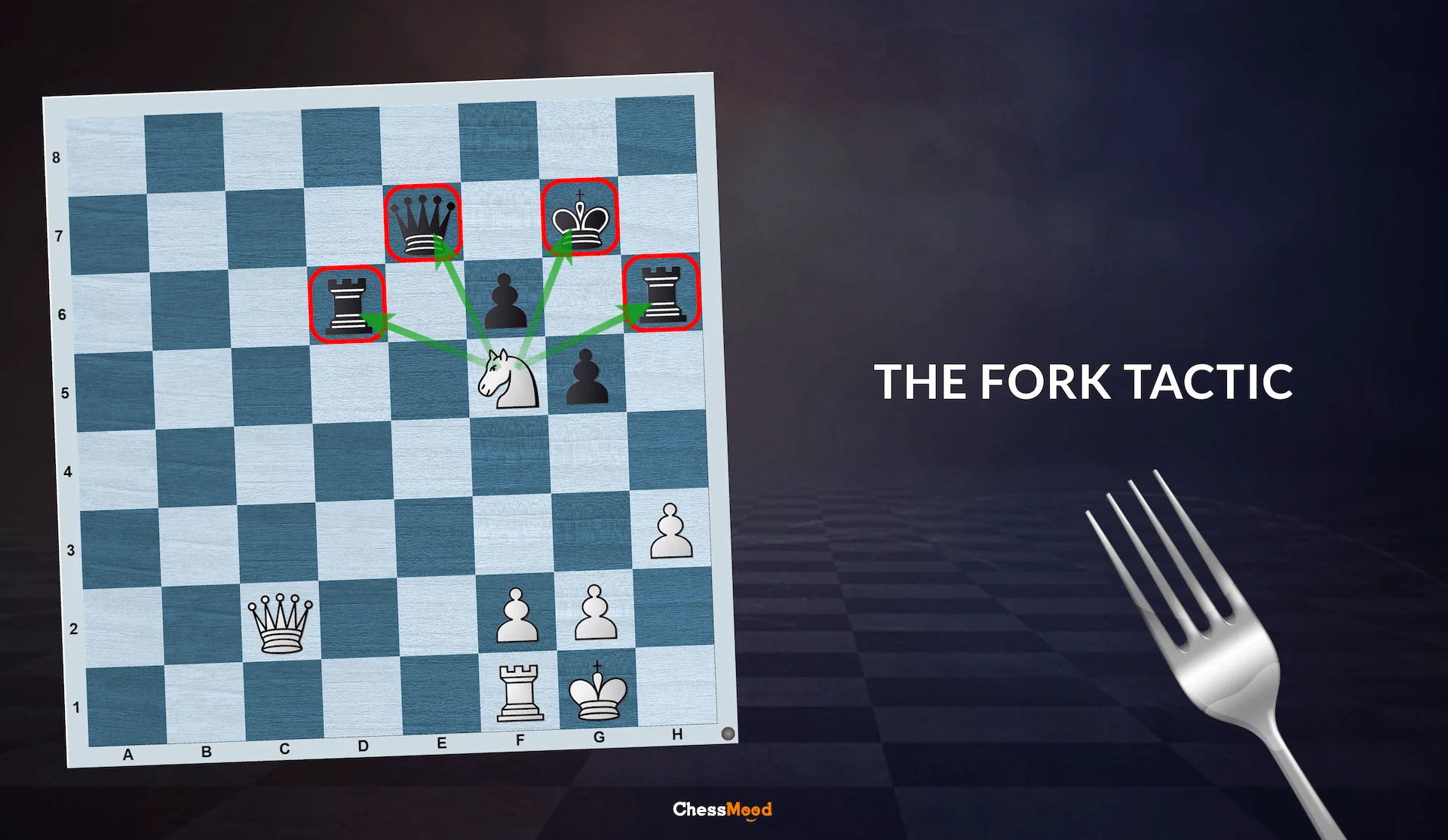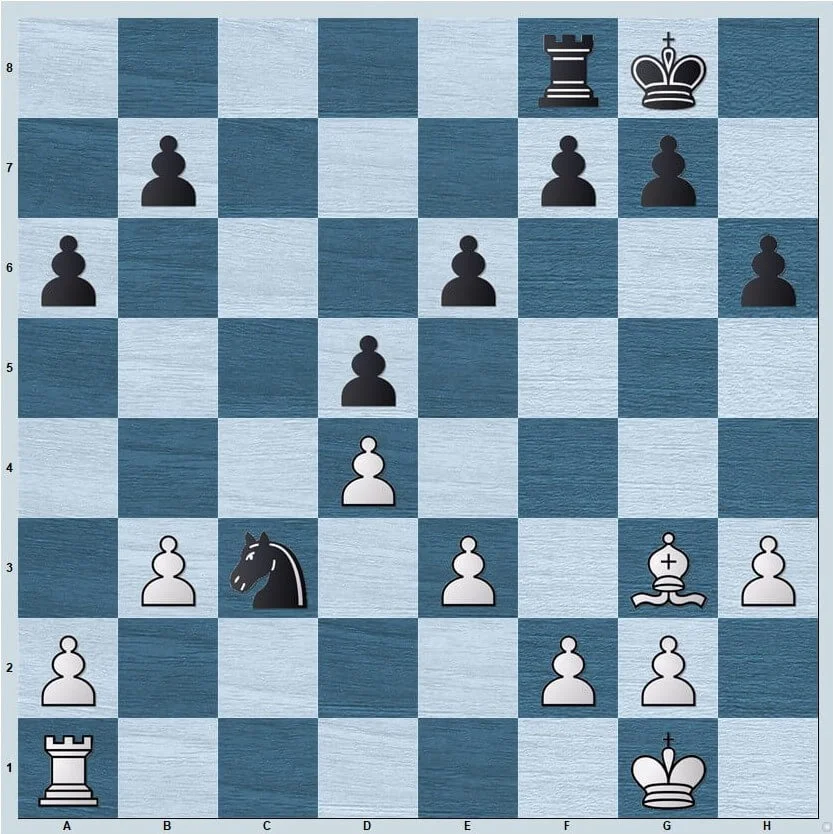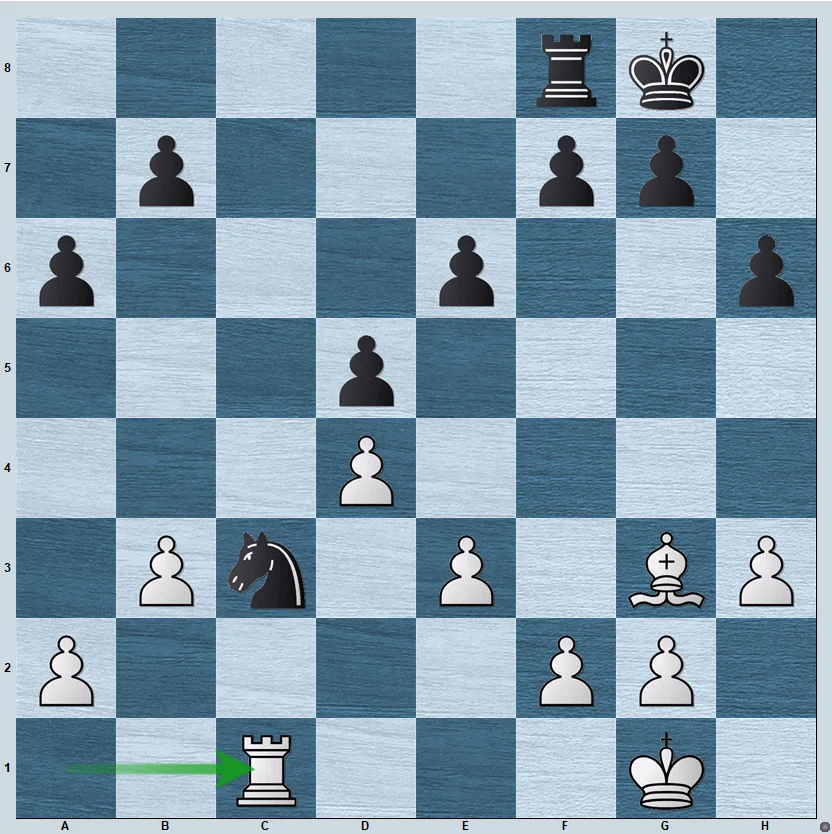The Fork Tactic in Chess Explained
Everything about the fork tactic: from what it is, how to get better at noticing it, what to do when you get forked, and more!
Everything about the fork tactic: from what it is, how to get better at noticing it, what to do when you get forked, and more!

I’ve seen many players miss the fork tactic, especially in a typical position like this:

Black’s Nc3 is unprotected. So the natural instinct for many is to attack it with 1.Rc1.

And then comes the decisive Knight fork: 1…Ne2+!

Ouch! After White moves the King, they lose the Rook.
Now it’s fun to win games like this.
But if you’re the one who falls into a fork like this, I understand it can be painful. You aren’t alone though.
Even Grandmasters fall victim to such forks, especially in faster time controls.
So what makes this tactic easy to miss for the untrained eye? I couldn’t find a clear answer until I asked a neurologist friend of mine.
And her insight didn’t just help me understand why it’s easy to miss the fork, but also how anyone can get better at noticing it!
I’ll share it here, along with everything important you need to know about this tactic like:
Before we begin, let me briefly explain the basics of this tactic.
A fork in chess is a tactic when a piece attacks two or more enemy pieces simultaneously. It’s a very common theme.
Let’s take another look at the introductory position. Black played 1…Ne2+!

…Attacking 2 pieces – the King and the Rook. This is a fork.
Since this tactic is about attacking two or more pieces at once, all pieces are capable of delivering it. At least technically.
But in the chess community, most people associate forks with the Knight. And when other pieces attack two or more pieces at once, it’s called a double attack tactic.
Another term you might hear in chess circles is the family fork. You might wonder what this is. And that brings us to the next section.
You don’t necessarily need to remember the names by heart, but it’s good to know what these are since they’re quite common in casual chess conversations.
Let’s begin with the most dangerous one.
An absolute fork is when a piece attacks two or more enemy pieces simultaneously, one of them being the King. This limits the ways in which the opponent can respond.
Like in the position below.
The Knight forks the King and Rook, forcing the King to move and limiting the Black’s options.

In this type of fork, the attacked piece could be any other except the King.
Here’s an example, with the Knight forking 2 Rooks.

In this fork, you attack the royal members on the chessboard, the King and the Queen at the same time.
White plays 1.Nf5+!

Everybody loves a good family fork! It’s when you attack a King, Queen, and Rook at the same time. It’s sometimes also called a grand fork.
I can still remember the happy face of our developer when he got a position like the one below!

Beauty! Just look at it!
The White Knight has the whole Black kingdom on fire. The Rooks, the Queen and the King – all are threatened by this one piece!
Positions like this are an absolute joy for many, especially when they spot it in a time scrabble!
This is when a Knight attacks the 4 other pieces at once – the King, Queen, Rook and Bishop. It’s also known as a quadruple fork!

As the name suggests, it’s when you cannot stop a fork. See the example below.
It’s White to play.

White plays 1.Nd5!

And there's no way to stop the Knight from landing on b6 and threatening 2 of Black's major pieces.
***
One thing I’ve noticed is that this tactic is harder to spot, not just for new players but also for strong Grandmasters.
When I asked this question to my neuroscientist friend, she gave me a fantastic insight.
Many things in our life, say for example cars, airplanes, and buildings – tend to move or be constructed in straight lines.
So our brains have seen enough to connect the neurons and recognize such patterns.
But how often do we see the L-shaped movement of a Knight?

I bet you don’t walk 2 steps forward and 1 step to the right, do you? Okay, at least when sober you don’t!🙂
In this case, our brain has relatively weaker neural connections which makes it harder to spot Knight forks.
Is there a fix to this? There is…
Now the most common advice you’ll get here is to practice more.
While it does help, I believe it’s more effective to address the fundamentals.
So the first exercise I recommend to my students is this:
Before you solve puzzles on the fork, help your brain visualize the L-shaped movement of the Knight.
Here’s how:

First, try to move your Knight from a1 to h8 (one corner to another) in the quickest possible way. You’re allowed to move the piece.
Is it too easy? Okay. Then, do it blindfolded!
Once you’re able to see the Knight move from a1-h8, visualize another path – put the Knight on a1 and get it g8, then from h1 to c8, h1 to g2, h1 to f3, and so on.
With more practice, you should be able to track the movement of the Knight more clearly while calculating. It will happen naturally as long as you put in the work.
Just like you train your leg muscles to get stronger, in the same way, you can solve specific examples of forks.
Once again, help your brain form stronger connections around this tactical pattern.
Generally, after my students do the above 2 exercises, I notice they get faster and more accurate at noticing this pattern.
It helps. Add it to your training too!
Moving on to the next section, I’ll share 5 positions for you to solve, based on this tactic.
Let’s start with a simple one. Black has carelessly played 1…Rfc8. And now it’s White’s turn.
The next one is slightly more challenging than you one you saw above. It’s White to play.
The next puzzle is where you must mix 2 tactics – a fork and a chess pin. This is a very common theme in many chess games.
It’s White to play and win. Look at the board, try to solve it before you check the solution.
The next one shows the fork tactic in the opening. It’s White to play.
And here’s the final one, from an endgame position with White to play.
We saw some examples of forking the opponent’s pieces. But what if you’re the one who lands in this tactical trouble? What do you do then?
The first and most important thing, when you are forked, is to not panic. Doing so will only stop you from thinking clearly. You don’t want that.
Instead, stay calm. Then look for options to get out.
You can use this strategy to get out of almost any tactic. The fork is no different.
Look at the position below.

The Knight forks the two Rooks but Black finds a way to save them with 1...Re1+! 2.Kg2 Rd8

Both the Rooks are out of danger.
In this case, you simply eliminate the piece delivering the tactic. This can be a very effective strategy if say you’re stuck in a family fork where more than 3-4 of your pieces are under attack.
Take the position below for instance.

It’s Black to play.
They are in a family fork with their Rooks and Queen under threat of capture. Luckily, there’s a hero Bishop to save the day! Black plays 1...Be4+

And after 2.Kg1 Bxd5, Black is out of danger.
This is a very useful strategy and it’s no different when it comes to this tactical pattern either.

White’s Knight forks the Black Queen and Rook. It seems like there’s no way to avoid losing material. And then Black’s Rook springs into action with 1...Re8! while escaping the fork.

Black threatens a mate on e1. And after White plays 2.h3 (to save the backrank mate), Black simply moves away their Queen, for example with 2...Qc5.
Just like a counterattack, you could also use other tactics to get out of a fork.
One of them is the lifeline. Grandmaster Johan Hellsten has written a detailed article on it. You can check it out to learn more about this tactic. For now, take a look at the position below:

So White’s Knight forks the Black Queen and Rook. What can Black do? If you notice, White’s Queen on e2 is not protected by anything.
Black can take advantage of this with 1....Qb5!

And now, if White captures the Queen, the Black Rook recaptures (2.Qxb5 Rxb5). And if White's knight captures the Rook, Black captures the White Queen (2.Nxb7 Qxe2).
These are just a few examples of how to get out of this tactic. As you improve your chess game you’ll intuitively begin to discover additional other ways as well.
What if you can’t do anything to escape from this tactic and losing material is unavoidable?
You minimize your losses🙂Simple.
Look at the game below:

White has forked Black’s Queen and Rook. What to do now? Lose as little material as possible. Black plays
1...Qd8! 2. Nxa8 Qxa8

Yes, Black is material down. But White still has a lot of work to do to win this position.
Congratulations! You now know the basics of the fork tactic. More examples along with explanations by a Grandmaster you can find in our Tactic Ninja course.

One of our most loved courses!
I’ll leave you with 4 puzzles to solve, all of which are White to play and win.
#1

#2

#3

#4

You can leave their solutions in the forum.
I hope you have a lot of fun and win many games with forks!
Related Reads
Grandmaster Guide to Improve Chess Tactics
The Skewer Tactic explained by a Grandmaster
Originally published May 30, 2023

